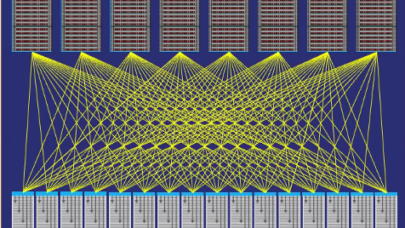
Cornelis Networks Wins $18M NNSA Award to Advance Omni-Path
May 4, 2022
Intel spinoff Cornelis Networks, custodian and developer of the Omni-Path networking portfolio, is now closer to reaching its next-gen networking roadmap targets thanks to an R&D contract with the Department of Energy’s National Nuclear Security Administration (NNSA). The contract is valued at $18 million. The Next-Generation High Performance Computing Network (NG-HPCN) project brings together NNSA labs and... Read more…

With New Owner and New Roadmap, an Independent Omni-Path Is Staging a Comeback
July 23, 2021
Put on a shelf by Intel in 2019, Omni-Path faced a uncertain future, but under new custodian Cornelis Networks, OmniPath is looking to make a comeback as an independent high-performance interconnect solution. A "significant refresh" – called Omni-Path Express – is coming later this year according to the company. Cornelis Networks formed last September as a spinout of Intel's Omni-Path division. Read more…

Intel Confirms Retreat on Omni-Path
August 1, 2019
Intel Corp.’s plans to make a big splash in the network fabric market for linking HPC and other workloads has apparently belly-flopped. The chipmaker confirmed to us the outlines of an earlier report by the website CRN that it has jettisoned plans for a second-generation version of its Omni-Path interconnect... Read more…

NERSC Scales Scientific Deep Learning to 15 Petaflops
August 28, 2017
A collaborative effort between Intel, NERSC and Stanford has delivered the first 15-petaflops deep learning software running on HPC platforms and is, according Read more…

Intersect360 Survey Shows Continued InfiniBand Dominance
July 4, 2017
There were few surprises in Intersect360 Research’s just released report on interconnect use in HPC. InfiniBand and Ethernet remain the dominant protocols acr Read more…

Dell EMC Adds Omni-Path Support to PowerEdge C6320p
May 9, 2017
A recent update by Dell EMC adds support for Intel’s high performance Omni-Path fabric on the PowerEdge C6320p modular server intended for HPC workloads. Noti Read more…

Lighting up Aurora: Behind the Scenes at the Creation of the DOE’s Upcoming 200 Petaflops Supercomputer
December 1, 2016
In April 2015, U.S. Department of Energy Undersecretary Franklin Orr announced that Intel would be the prime contractor for Aurora: a leadership-class, 200 peta Read more…

Omni-Path Steadily Gaining Market Traction Says Intel
April 26, 2016
Intel’s Omni-Path Architecture (OPA), a centerpiece of its Scalable System Framework (SSF), has been shipping for a full quarter now and according to Barry Davis, general manager, HPC Compute & Networks at Intel, OPA is doing well contrary to suggestions from a competitor. Read more…

- Click Here for More Headlines

Whitepaper
Transforming Industrial and Automotive Manufacturing
In this era, expansion in digital infrastructure capacity is inevitable. Parallel to this, climate change consciousness is also rising, making sustainability a mandatory part of the organization’s functioning. As computing workloads such as AI and HPC continue to surge, so does the energy consumption, posing environmental woes. IT departments within organizations have a crucial role in combating this challenge. They can significantly drive sustainable practices by influencing newer technologies and process adoption that aid in mitigating the effects of climate change.
While buying more sustainable IT solutions is an option, partnering with IT solutions providers, such and Lenovo and Intel, who are committed to sustainability and aiding customers in executing sustainability strategies is likely to be more impactful.
Learn how Lenovo and Intel, through their partnership, are strongly positioned to address this need with their innovations driving energy efficiency and environmental stewardship.
Download Now
Sponsored by Lenovo
Whitepaper
How Direct Liquid Cooling Improves Data Center Energy Efficiency
Data centers are experiencing increasing power consumption, space constraints and cooling demands due to the unprecedented computing power required by today’s chips and servers. HVAC cooling systems consume approximately 40% of a data center’s electricity. These systems traditionally use air conditioning, air handling and fans to cool the data center facility and IT equipment, ultimately resulting in high energy consumption and high carbon emissions. Data centers are moving to direct liquid cooled (DLC) systems to improve cooling efficiency thus lowering their PUE, operating expenses (OPEX) and carbon footprint.
This paper describes how CoolIT Systems (CoolIT) meets the need for improved energy efficiency in data centers and includes case studies that show how CoolIT’s DLC solutions improve energy efficiency, increase rack density, lower OPEX, and enable sustainability programs. CoolIT is the global market and innovation leader in scalable DLC solutions for the world’s most demanding computing environments. CoolIT’s end-to-end solutions meet the rising demand in cooling and the rising demand for energy efficiency.
Download Now
Sponsored by CoolIT
Advanced Scale Career Development & Workforce Enhancement Center
Featured Advanced Scale Jobs:
HPCwire Resource Library
HPCwire Product Showcase
© 2024 HPCwire. All Rights Reserved. A Tabor Communications Publication
HPCwire is a registered trademark of Tabor Communications, Inc. Use of this site is governed by our Terms of Use and Privacy Policy.
Reproduction in whole or in part in any form or medium without express written permission of Tabor Communications, Inc. is prohibited.
























